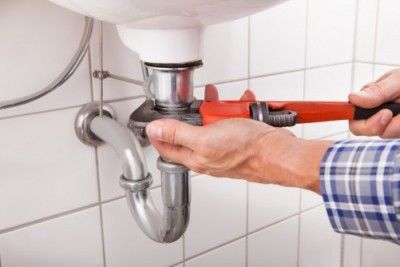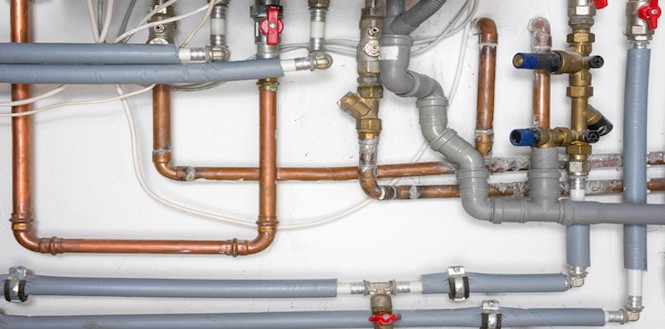The Anatomy of Your House's Plumbing System Explained
The Anatomy of Your House's Plumbing System Explained
Blog Article
Almost everyone may have their own unique theory about Plumbing Installation 101: All You Need to Know.

Understanding exactly how your home's plumbing system works is crucial for each homeowner. From delivering clean water for alcohol consumption, food preparation, and showering to securely getting rid of wastewater, a properly maintained pipes system is vital for your family members's health and wellness and convenience. In this comprehensive overview, we'll discover the complex network that comprises your home's plumbing and deal suggestions on upkeep, upgrades, and dealing with usual problems.
Intro
Your home's pipes system is more than just a network of pipelines; it's a complicated system that guarantees you have accessibility to tidy water and effective wastewater elimination. Recognizing its parts and exactly how they collaborate can help you prevent pricey repair services and make sure every little thing runs smoothly.
Basic Elements of a Plumbing System
Pipes and Tubes
At the heart of your plumbing system are the pipes and tubes that bring water throughout your home. These can be constructed from different materials such as copper, PVC, or PEX, each with its benefits in regards to sturdiness and cost-effectiveness.
Fixtures: Sinks, Toilets, Showers, and so on.
Components like sinks, bathrooms, showers, and tubs are where water is used in your house. Understanding just how these fixtures connect to the pipes system aids in detecting issues and planning upgrades.
Shutoffs and Shut-off Points
Shutoffs manage the flow of water in your pipes system. Shut-off valves are critical during emergency situations or when you need to make repairs, permitting you to isolate parts of the system without interfering with water circulation to the entire house.
Water System System
Key Water Line
The primary water line attaches your home to the local water supply or an exclusive well. It's where water enters your home and is dispersed to different components.
Water Meter and Stress Regulatory Authority
The water meter measures your water usage, while a stress regulatory authority makes sure that water flows at a risk-free stress throughout your home's plumbing system, protecting against damage to pipelines and fixtures.
Cold Water vs. Hot Water Lines
Recognizing the distinction between cold water lines, which provide water directly from the major, and warm water lines, which carry heated water from the hot water heater, helps in repairing and planning for upgrades.
Drain System
Drain Pipes Pipeline and Traps
Drain pipes carry wastewater away from sinks, showers, and commodes to the sewer or sewage-disposal tank. Catches prevent sewer gases from entering your home and likewise catch debris that might create clogs.
Ventilation Pipelines
Air flow pipes enable air right into the water drainage system, preventing suction that could slow down drain and trigger traps to vacant. Correct ventilation is vital for keeping the integrity of your plumbing system.
Significance of Correct Water Drainage
Ensuring proper water drainage prevents backups and water damages. Consistently cleaning drains pipes and keeping traps can avoid expensive repair services and expand the life of your pipes system.
Water Heating System
Types of Water Heaters
Water heaters can be tankless or conventional tank-style. Tankless heating units warmth water as needed, while storage tanks keep warmed water for instant usage.
Just How Water Heaters Attach to the Pipes System
Recognizing how hot water heater attach to both the cold water supply and hot water circulation lines aids in detecting concerns like not enough warm water or leaks.
Maintenance Tips for Water Heaters
Frequently purging your hot water heater to eliminate sediment, checking the temperature setups, and inspecting for leaks can expand its life expectancy and enhance energy effectiveness.
Common Plumbing Concerns
Leakages and Their Causes
Leaks can occur due to aging pipes, loosened installations, or high water pressure. Addressing leaks promptly protects against water damages and mold growth.
Clogs and Obstructions
Blockages in drains and toilets are often brought on by flushing non-flushable items or a buildup of oil and hair. Making use of drainpipe screens and being mindful of what goes down your drains pipes can stop blockages.
Signs of Pipes Problems to Watch For
Low tide stress, sluggish drains, foul odors, or abnormally high water expenses are indications of prospective pipes issues that should be resolved immediately.
Plumbing Maintenance Tips
Normal Inspections and Checks
Set up yearly plumbing examinations to capture issues early. Seek signs of leakages, rust, or mineral build-up in taps and showerheads.
DIY Upkeep Tasks
Easy tasks like cleansing faucet aerators, looking for commode leaks making use of color tablets, or shielding subjected pipelines in chilly climates can avoid significant plumbing issues.
When to Call an Expert Plumbing
Know when a pipes problem calls for professional know-how. Attempting intricate repair work without correct understanding can bring about more damages and greater repair service prices.
Upgrading Your Pipes System
Reasons for Upgrading
Updating to water-efficient fixtures or replacing old pipelines can improve water high quality, reduce water expenses, and raise the value of your home.
Modern Pipes Technologies and Their Benefits
Explore innovations like smart leak detectors, water-saving commodes, and energy-efficient water heaters that can conserve money and lower environmental influence.
Cost Considerations and ROI
Compute the upfront expenses versus lasting savings when thinking about pipes upgrades. Lots of upgrades spend for themselves through minimized utility costs and less fixings.
Environmental Effect and Preservation
Water-Saving Fixtures and Home Appliances
Setting up low-flow taps, showerheads, and commodes can significantly reduce water usage without compromising efficiency.
Tips for Reducing Water Usage
Easy behaviors like fixing leaks immediately, taking much shorter showers, and running complete loads of laundry and meals can save water and reduced your energy costs.
Eco-Friendly Pipes Options
Consider sustainable plumbing materials like bamboo for floor covering, which is durable and green, or recycled glass for counter tops.
Emergency Preparedness
Steps to Take During a Pipes Emergency
Know where your shut-off valves are located and how to shut off the water system in case of a burst pipeline or major leak.
Value of Having Emergency Situation Calls Handy
Maintain contact information for neighborhood plumbers or emergency services readily available for quick response throughout a pipes dilemma.
Do It Yourself Emergency Situation Fixes (When Relevant).
Momentary repairs like utilizing air duct tape to spot a dripping pipeline or positioning a container under a leaking tap can lessen damage up until a professional plumbing arrives.
Conclusion.
Understanding the anatomy of your home's pipes system encourages you to keep it effectively, conserving money and time on repair work. By following regular upkeep routines and staying educated regarding modern-day pipes technologies, you can guarantee your plumbing system operates efficiently for several years to come.
Understanding Your Home Plumbing System: A Comprehensive Guide
Plumbing System: The Lifeline of Your Home
At its core, the plumbing system is designed to perform two primary functions: bring fresh water into your home and remove wastewater. The system is a network of pipes, fixtures, and other components that transport water and sewage. Residential plumbing systems include potable water supply lines, drain-waste-vent (DWV) systems, and various plumbing fixtures that make water use in daily tasks possible.
Key Components:
Water Supply: This part of your plumbing system brings municipal water into your home, passing through the main water supply line. It s responsible for supplying all water needs, from drinking to bathing.
Drainage System: It carries waste and water away from your home to the sewer or septic system. This system includes all the piping within your home that leads to external sewage or septic systems.
Vent System: An essential yet often overlooked component, the vent system allows sewer gases to escape and lets air into the drainpipes, ensuring water and waste move correctly through the system.
Fixture: More Than Just Taps and Toilets
Plumbing fixtures are the most interactive parts of the plumbing system, including faucets, showers, toilets, and sinks. Each fixture is connected to the plumbing system and plays a role in either the delivery of freshwater or the disposal of waste and wastewater.
Types of Fixtures:
Faucets and Sinks: Used for washing hands, dishes, and other daily water needs.
Toilets: Dispose of human waste through the sewage system.
Bathtubs and Showers: Provide bathing facilities, requiring both hot and cold water supply.
Water Supply: The Source of Life
The water supply system is a critical component, ensuring that potable water is available throughout your home for various uses, including drinking, cooking, and cleaning. This system consists of pipes that distribute water to different parts of the house, controlled by valves to regulate the water flow.
Types of Plumbing: Materials and Methods
Various types of plumbing systems and materials are used in residential settings, each with its advantages and applications. From copper and PVC pipes for water supply to cast iron and ABS for drainage, the choice of materials can impact the longevity and efficiency of your plumbing system.
https://intownplumbingtx.com/articles/home-plumbing-system-guide/

Understanding Your Home Plumbing System: A Comprehensive Guide
Plumbing System: The Lifeline of Your Home
At its core, the plumbing system is designed to perform two primary functions: bring fresh water into your home and remove wastewater. The system is a network of pipes, fixtures, and other components that transport water and sewage. Residential plumbing systems include potable water supply lines, drain-waste-vent (DWV) systems, and various plumbing fixtures that make water use in daily tasks possible.
Key Components:
Water Supply: This part of your plumbing system brings municipal water into your home, passing through the main water supply line. It s responsible for supplying all water needs, from drinking to bathing.
Drainage System: It carries waste and water away from your home to the sewer or septic system. This system includes all the piping within your home that leads to external sewage or septic systems.
Vent System: An essential yet often overlooked component, the vent system allows sewer gases to escape and lets air into the drainpipes, ensuring water and waste move correctly through the system.
Fixture: More Than Just Taps and Toilets
Plumbing fixtures are the most interactive parts of the plumbing system, including faucets, showers, toilets, and sinks. Each fixture is connected to the plumbing system and plays a role in either the delivery of freshwater or the disposal of waste and wastewater.
Types of Fixtures:
Water Supply: The Source of Life
The water supply system is a critical component, ensuring that potable water is available throughout your home for various uses, including drinking, cooking, and cleaning. This system consists of pipes that distribute water to different parts of the house, controlled by valves to regulate the water flow.
Types of Plumbing: Materials and Methods
Various types of plumbing systems and materials are used in residential settings, each with its advantages and applications. From copper and PVC pipes for water supply to cast iron and ABS for drainage, the choice of materials can impact the longevity and efficiency of your plumbing system.
https://intownplumbingtx.com/articles/home-plumbing-system-guide/
Hopefully you enjoyed reading our excerpt on The Inner Workings of Your Home's Plumbing. Thank you so much for spending some time to read our piece of content. Feel free to take a moment to distribute this post if you enjoyed reading it. Thanks so much for taking the time to read it.
Call Today Report this page